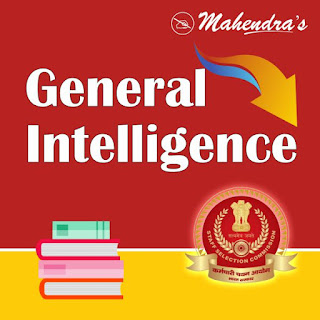As SSC CGL /CHSL notification is out and candidates have started their preparation for this exam. Mahendras also has started special quizzes for this examination. This series of the quizzes is based on the latest pattern of the SSC CGL/CHSL examination. Regular practice of the questions included in the quizzes will boost up your preparations and it will be very helpful in scoring good marks in the examination.
Q.1. Read the given statements and conclusions carefully. Assuming that the information given in the statements is true, even if it appears to be at variance with commonly known facts, decide which of the given conclusions logically follow(s) from the statements.
Statement-
All warehouses are storehouses.
Some storehouses are buildings.
Conclusion-
I. No building is a storehouse.
II. Some warehouses are buildings.
1. Only conclusion I follows
2. Both conclusions I and II follow.
3. Only conclusion II follows.
4. Neither conclusion I nor conclusion II follows.
दिए गए कथनों और निष्कर्षों को ध्यान से पढ़ें। यह मानते हुए कि कथनों में दी गई जानकारी सही है, भले ही यह सामान्य रूप से ज्ञात तथ्यों के साथ विचरण करती हो, यह तय करें कि दिए गए निष्कर्षों में से कौन सा कथन से तार्किक रूप से अनुसरण करता है।
कथन-
सभी गोदाम भंडारगृह है।
कुछ भंडारगृह भवन है।
निष्कर्ष-
I. कोई भी भवन भंडारगृह नहीं है।
II. कुछ गोदाम भवन है।
1. केवल निष्कर्ष I अनुसरण करता है।
2. दोनों निष्कर्ष I और II अनुसरण करते है।
3. केवल निष्कर्ष II अनुसरण करता है।
4. न तो निष्कर्ष I और न ही निष्कर्ष II अनुसरण करता है।
Q.2 Select the option that is related to the third term in the same way as the second term is related to the first term.
उस विकल्प का चयन करें जो तीसरे पद से उसी प्रकार संबंधित है जैसे दूसरा पद पहले पद से संबंधित है।
7 : 42 :: 9 : ?
1. 49
2. 72
3. 90
4. 81
Q.3. In a certain code language, JACKET is written as 8-25-1-9-3-18 then how will SWEATER be written in the same code language?
एक निश्चित कोड भाषा में, JACKET को 8-25-1-9-3-18 के रूप में लिखा जाता है फिर उसी कोड भाषा में SWEATER को कैसे लिखा जाएगा?
1. 17-21-3-25-18-3-16
2. 19-22-4-26-17-4-17
3. 19-23-5-27-20-5-17
4.17-20-2-24-18-3-16
Q.4. In the following figure, the rectangle represents the artists, the triangle represents the writers, the circle represents the social workers and the square represents the father. Which set of letters represents social workers who are not fathers?
निम्न आकृति में, आयत कलाकारों को दर्शाता है, त्रिकोण लेखकारों को दर्शाता है, वृत्त सामाजिक कार्यकर्ताओं को दर्शाता है और वर्ग पिता को दर्शाता है। कौन-सा अक्षरों का समूह सामाजिक कार्यकर्ताओं को दर्शाता है जो पिता नहीं है?

1. GFH
2. IGF
3. DEB
4. GAI
Q.5 Select the term that will come next in the following series.
निम्नलिखित श्रृंखला में आने वाले अगले पद का चयन करें।
BDf, GIk, LNp, ...
1. QSu
2. QTu
3. QTv
4. QSU
Q.6-7. In the following questions, the relationship between different elements is shown in the statement. These statements are followed by conclusions. Find which of the conclusions given below them is in doubtful condition.
निम्नलिखित प्रश्नों में, कथनों में विभिन्न तत्वों के बीच संबंध दर्शाये गये हैं। इन कथनों के बाद निष्कर्षों को दिया गया हैं। ज्ञात कीजिये कि दिये गये निष्कर्षों में से कौन-सा संदेहात्मक स्थिति में है।
Q.6. Statements: ZO ≤ EV≤ TW < FF ≤ SS= EE
Conclusions:
1. EV< EE
2. SS> EV
3. ZO= EV
4. TW > FF
कथन: ZO≤ EV≤ TW< FF ≤ SS= EE
निष्कर्ष:
1. EV< EE
2. SS> EV
3. ZO= EV
4. TW> FF
Q.7. Statements:
EE = FF ≤ SS ≤ TH > EV > ZO
Conclusions:
1. FF ≤ EV
2. EE ≤ SS
3. FF = EE
4. TH > ZO
कथन: EE = FF ≤ SS ≤ TH > EV >ZO
निष्कर्ष:
1. FF ≤ EV
2. EE ≤ SS
3. FF = EE
4. TH > ZO
Q.8-10. Study the following arrangement and answer the questions given below.
निम्नलिखित व्यवस्था का अध्ययन करें और नीचे दिए गए प्रश्नों के उत्तर दें।
Y % R 4 8 E 6 ! U 1 K @ J 3 D # F G A © * Q O 9 L 5 & P W 2 X N Z
Q.8. If all the symbols and the numbers in the above arrangement are dropped, which of the following will be the tenth from the left end?
यदि उपरोक्त व्यवस्था में सभी प्रतीकों और संख्याओं को हटा दिया जाता है तो निम्न में से कौन सा बायें छोर से दसवां होगा?
1. Y
2. N
3. P
4. A
Q.9. How many such symbols are there in the above arrangement each of which is immediately preceded by a number and immediately followed by a letter?
1. None
2. One
3. Two
4. Three
उपरोक्त व्यवस्था में ऐसे कितने प्रतीक है जिनमें से प्रत्येक के तुरन्त पहले एक संख्या और तुरन्त बाद एक अक्षर है?
1. कोई नहीं
2. एक
3. दो
3. तीन
Q.10. How many such consonants are there in the above arrangement each of which is immediately followed by a symbol but not immediately preceded by a number?
1. None
2. One
3. Two
4. Three
उपरोक्त व्यवस्था में ऐसे कितने व्यजंन है जिनमें से प्रत्येक के एकदम बाद एक प्रतीक किन्तु एकदम पहले एक संख्या नहीं है?
1. कोई नहीं
2. एक
3. दो
4. तीन
ANSWER-
Q.1. (4)


Q.2. (2)
7 = 7 x 7 – 7 = 42
9 = 9 x 9 – 9 = 72
Q.3. (1)
JACKET = HYAIBR = 8 25 1 9 2 18
Q.4. (4)
Q.5. (1)
B (+5) G (+5) L (+5) Q
D (+5) I (+5) N (+5) S
f (5) k (+5) p (+5) u
Q.6. (3)
Q.7. (1)
Q.8. (5)
Q.9. (3) 6!U, 5 & P
Q.10. (1)






0 comments:
Post a Comment
MAHENDRA GURU